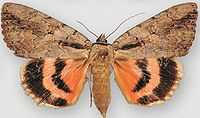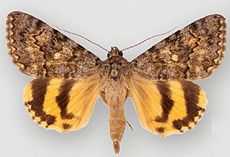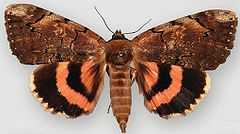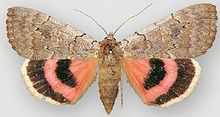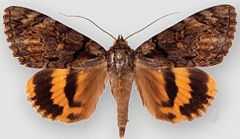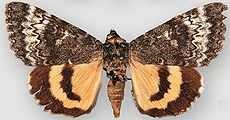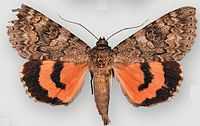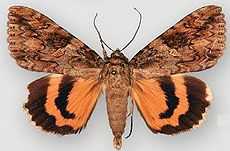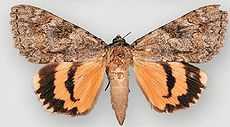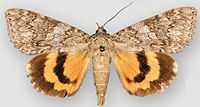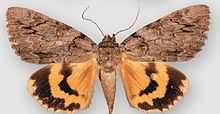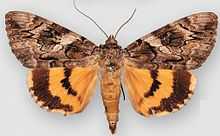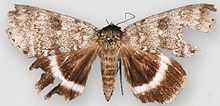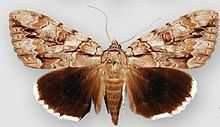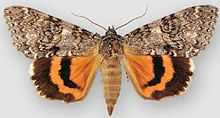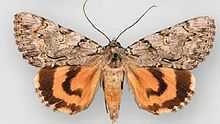Catocala
- Eucorna and Lamprosia redirect here. For the metalmark butterfly and arctiid moth genera, respectively, see Voltinia (butterfly) and Lamprosiella.
| Underwing moths | |
|---|---|
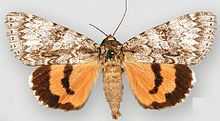 | |
| Semirelict Underwing (C. semirelicta) Imago of the pura form from above | |
| Scientific classification | |
| Kingdom: | Animalia |
| Phylum: | Arthropoda |
| Class: | Insecta |
| Order: | Lepidoptera |
| Family: | Noctuidae (but see text) |
| Tribe: | Catocalini |
| Subtribe: | Catocalina |
| Genus: | Catocala Schrank, 1802 |
| Type species | |
| Phalaena nupta Linnaeus, 1767 | |
| Diversity | |
| About 270 species | |
| Synonyms | |
|
Numerous, see text | |
Catocala is a generally Holarctic genus of owlet moths (family Noctuidae or superfamily Noctuoidea – see below) commonly known as underwing moths or simply underwings. These terms are sometimes used for a few related moths, but usually – especially when used in plural, not as part of a species name – it is used to refer to Catocala only. They are traditionally placed in the subfamily Catocalinae, and therein in subtribe Catocalina of the large tribe Catocalini. Of these taxa, they form the type genus.
Of the more than 250 known species, slightly less than half are found in North America – mostly in the United States – while the rest occur in Eurasia. Of these, about one-fifth (almost 30 species) is native to Europe. A few range into the northern Neotropics and Indomalaya.[1]
Description and ecology
Most species of Catocala are mid-sized to largish moths, cryptically coloured except for the hindwings, which are marked with stripes in orange, red, white, or even blue. In some, the hindwings are mostly blackish. Unlike what the common name "underwings" seems to suggest, the colour is brightest on the upperside. However, the bright hindwings are not visible at rest, being hidden under the dull forewings – hence the name. Due to their diversity and variety of colors and patterns, underwing moths are popular with collectors of Lepidoptera.
It is believed that the bright colors, arranged in usually roughly concentric markings, at a casual glance resemble the eyes of a predatory animal, such as a cat. An underwing moth, well camouflaged in its daytime resting spot on a tree trunk or branch, will suddenly flash open the hindwings when disturbed. A bird or other small predator that is not used to this display is likely to be frightened, allowing the moth to escape. However, unlike some other bright-colored moths which are bad-tasting or even poisonous to predators, underwing moths are well palatable at least to some birds (e.g. the Blue Jay, Cyanocitta cristata). To assist in avoiding nocturnal predators such as bats, these moths also possess (like many of their relatives) fairly well-developed hearing organs.[2]
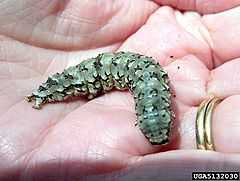
The caterpillar larvae of most species feed on the leaves of woody plants, usually trees but sometimes shrubs. Typical foodplants are Fagales of the families Betulaceae, Fagaceae and Juglandaceae – mainly hickory (Carya), oak (Quercus) and walnut tree (Juglans) speecies, as well as others such as alder (Alnus), beech (Fagus), birch (Betula) and chestnut (Castanea). The caterpillars of numerous Old World and some North American species feed on the Salicaceae Populus (poplars) and Salix (willows), which belong to the Malpighiales. Less common larval foodplants of Catocala are for example elms (Ulmus) and various Rosaceae of the Rosales, Tilia (linden and basswood) of the Malvales, or some Fabaceae of the Fabales; as the preceding, these all belong to the Fabidae lineage of rosid eudicots. More unusually, underwing moth caterpillars have also been found to feed on such plants as maple (Acer) which belongs to a distant lineage of rosids, as well as on such plants as ash trees (Fraxinus) and blueberries (Vaccinium) which are asterids and quite unrelated to the other foodplants by eudicot standards.[3]
The adults are predominantly nocturnal, flying from shortly after dusk right up to daybreak. They are generally most active about two hours after nightfall. However, several if not all species of underwing moths have a second activity period exactly around noon, during which they are also regularly found on the wing for about 1-2 hours each day.[4]
Classification
The genus name Catocala roughly means "beautiful hindwings". It is a combination of two Ancient Greek words, kato (κάτω, "the rear one" or "the lower one"), and kalos (καλός, "beautiful").[5]
Traditionally, this genus is placed in the family Noctuidae. In an alternate taxonomic treatment, where the Noctuidae are circumscribed more restrictedly, the Catocalinae as defined here are merged with the Erebinae to form a family Erebidae which is placed with the remaining Noctuidae in superfamily Noctuoidea. In this scheme, the Catocalini and Catocalina are upranked to subfamily and full tribe, respectively, within the Erebidae.
The species of Catocala are here divided into a Eurasian group, and another one which is found in North America. This does not imply actual relationships; it is mainly done to more conveniently deal with the large number of species e.g. in faunistic studies. Still, it is not unlikely at all that the groups consist at least to some extent of closely related species.[6]
There are several cryptic species complexes in Catocala, e.g. the group around the Delilah Underwing (C. delilah); these and other hitherto unknown species are still being discovered and described in some numbers. Thus, resolving the phylogeny and taxonomy of the underwing moths is an ongoing effort, which has made (as of 2011) little progress. In the scientific literature, smaller subdivisions into putatively related species are sometimes applied, but there is no consistent and widely accepted taxonomic treatment for the genus as a whole.
Several distinct genera have formally been proposed for splitting from Catocala, but these are all treated here as junior synonyms. These synonyms and other invalid names of Catocala are:[7]
|
|
Palearctic species
|
|
|
Comparison of Eurasian species
-
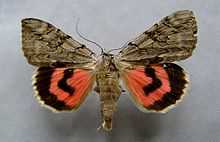
Catocala electa
Rosy Underwing -

Catocala elocata
French Red Underwing -
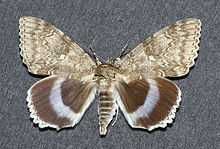
Catocala fraxini
Blue Underwing
Type species of Hemigeometra -

Catocala fulminea
Type species of Ephesia -
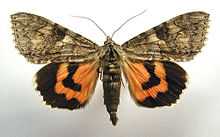
Catocala nupta
Red Underwing
Type species of Catocala -
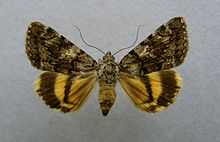
Catocala nymphagoga
Oak Yellow Underwing -

Catocala promissa
Light Crimson Underwing -
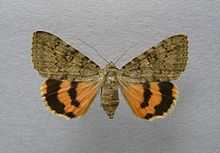
Catocala puerpera
Type species of Eunetis -
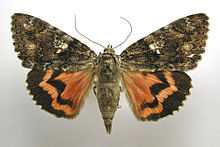
Catocala sponsa
Dark Crimson Underwing
Nearctic species
|
|
|
Comparison of North American species
-
Catocala amatrix f. nurus
Sweetheart Underwing
Type species of Lamprosia -
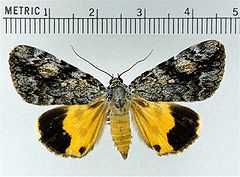
Catocala amica
Girlfriend Underwing
Type species of Corisce -
Catocala benjamini benjamini
Benjamin's Underwing -
Catocala carissima
Carissima Underwing -
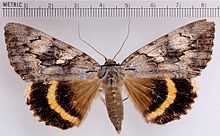
Catocala cerogama
Yellow-banded Underwing -
Catocala concumbens
Pink Underwing -
Catocala connubialis f. sancta
Connubial Underwing -
Catocala delilah
Delilah Underwing -
Catocala grotiana
Grote's Underwing -
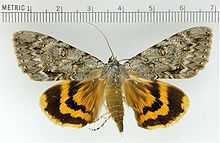
Catocala habilis
Habilis Underwing -
Catocala hermia f. diantha
Hermia Underwing -
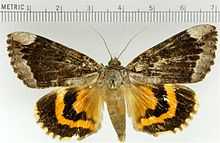
Catocala innubens
Betrothed Underwing -
Catocala irene
Irene's Underwing -
Catocala jessica
Jessica Underwing -
Catocala meskei f. rosalinda
Meske's Underwing -
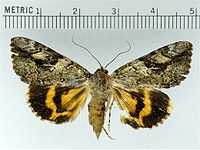
Catocala micronympha
Little Nymph Underwing -
Catocala neogama euphemia
The Bride -
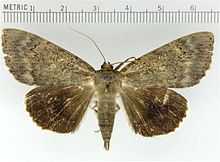
Catocala obscura
Obscure Underwing -
Catocala piatrix dionyza
Penitent Underwing -
Catocala relicta f. elda
The Relict -
Catocala retecta luctuosa
Yellow-fringed Underwing -
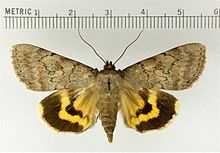
Catocala serena
Serene Underwing -
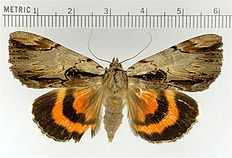
Catocala ultronia
Dark Red Underwing -
Catocala unijuga
Once-married Underwing -
Catocala verrilliana f. beutenmuelleri
Verrill's Underwing
Other "underwing moths"
As noted in the introduction, there are a few other moths which are commonly known as "underwings". Typically however, the name is used with a qualifier, such as a color term, in these cases. Non-Catocala "underwing moths" are typically owlet moths, namely:
Subfamily Catocalinae
Subfamily Amphipyrinae
Subfamily Erebinae
|
Subfamily Hadeninae
Subfamily Noctuinae
|
However, the "orange underwings" are two species of genus Archiearis of the geometer moth family (Geometridae):
- Orange Underwing (Archiearis parthenias)
- Light Orange Underwing (Archiearis notha)
-
Black Underwing
Mormo maura
Hadeninae -

Broad-bordered White Underwing
Hadula melanopa
Hadeninae -
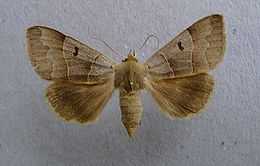
Brown Underwing
Minucia lunaris
Catocalinae -
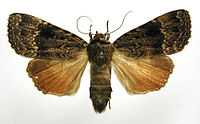
Copper Underwing
Amphipyra pyramidea
Amphipyrinae -
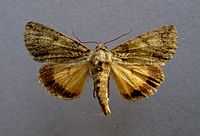
Guernsey Underwing
Polyphaenis sericata
Hadeninae -

Large Yellow Underwing
Noctua pronuba
Noctuinae -

Light Orange Underwing
Archiearis notha
Geometridae: Archiearinae -

Pearly Underwing
Peridroma saucia
Noctuinae -

Small Dark Yellow Underwing
Coranarta cordigera
Hadeninae -

White Underwing
Catephia alchymista
Catocalinae
Footnotes
- ↑ FE (2011), and see references in Savela (2012)
- ↑ Fullard & Napoleone (2001), Stevens (2005)
- ↑ Nelson & Loy (1983), and see references in Savela (2012)
- ↑ Fullard & Napoleone (2001)
- ↑ Woodhouse (1910)
- ↑ See references in Savela (2012)
- ↑ Pitkin & Jenkins (2004b)
- ↑ "Blepharonia" was initially proposed as name for a tribe in 1823, and only established as a genus name Blepharonia in 1825: Pitkin & Jenkins (2004a).
References
- Fauna Europaea (FE) (2011): Catocala. Version 2.4, 2011-JAN-27. Retrieved 2012-MAR-29.
- Fullard, James H. & Napoleone, Nadia (2001): Diel flight periodicity and the evolution of auditory defences in the Macrolepidoptera. Animal Behaviour 62(2): 349–368. doi:10.1006/anbe.2001.1753 PDF fulltext
- Nelson, John M. & Loy, Peter W. (1983): The Underwing Moths (Lepidoptera: Noctuidae) of Oklahoma. Proceedings of the Oklahoma Academy of Science 63: 60-67. PDF fulltext
- Pitkin, Brian & Jenkins, Paul (2004a): Butterflies and Moths of the World, Generic Names and their Type-species – Blepharonia Hübner 1823. Version of 2004-NOV-05. Retrieved 2012-MAR-29.
- Pitkin, Brian & Jenkins, Paul (2004b): Butterflies and Moths of the World, Generic Names and their Type-species – Catocala. Version of 2004-NOV-05. Retrieved 2012-MAR-29.
- Savela, Markku (2012): Markku Savela's Lepidoptera and some other life forms – Catocala. Version of 2012-FEB-05. Retrieved 2012-MAR-29.
- Stevens, Martin (2005): The role of eyespots as anti-predator mechanisms, principally demonstrated in the Lepidoptera. Biological Reviews 80(4): 573–588. doi:10.1017/S1464793105006810 PDF fultlext
- Woodhouse, S. C. (1910): English-Greek Dictionary – A Vocabulary of the Attic Language. George Routledge & Sons Ltd., Broadway House, Ludgate Hill, E.C. Searchable JPEG fulltext
Further reading
- Ishizuka, K. (2002). "Notes on Catocala columbina Leech, 1900 (Lepidoptela, Noctuidae), with description of new taxa." Gekkan-Mushi (379): 12-13.
- Ishizuka, K. (2007). "A new species of Catocala Schrank, 1802 from Western China (Lepidoptera, Noctuidae)." Gekkan-Mushi (439): 22-24.
- Kravchenko, V. D. et al. (2008). "New underwing taxa of the section of Catocala lesbia Christoph, 1887 (Lepidoptera: Noctuidae)." Acta Zoologica Lituanica 18(1): 30-49.
- Kravchenko, V. D., Speidel, W., et al. (2008). "A new species of Catocala from Israel (Lepidoptera: Noctuidae)." Acta Zoologica Lituanica 18(2): 127-129.
- Leech, J. J. (1900). Trans. ent. Soc. London 1900: 511-663.
- Lewandowski, S. & Tober, K. (2008). "Catocala olgaorlovae duschara subspec. nov. aus Jordanien (Lepidoptera: Noctuidae)." Atalanta 39(1-4): 377-378.
- Saldaitis, A. & Ivinskis, P. (2008). "Catocala florianii, a new species (Lepidoptera: Noctuidae) from China." Acta Zoologica Lituanica 18(2): 124-126.
- Sinyaev, V., Saldaitis, A. & Ivinskis, P. (2007). Acta Zoologica Lituanica 17(4): 272-275.
- Speidel, W., Ivinskis, P. & Saldaitis, A. (2008). "A new Catocala species (Lepidoptera: Noctuidae) from China." Acta Zoologica Lituanica 18(2): 122-123.
- Weisert, F. (1998). Zeitschrift der Arbeitsgemeinschaft der Österreichischen Entomologen 50: 125-126.
External links
| Wikimedia Commons has media related to Catocala. |

